Qualcomm Announces New Snapdragon Wear 4100 & 4100+: 12nm A53 Smartwatches
by Andrei Frumusanu on June 30, 2020 11:00 AM EST- Posted in
- Wearables
- Qualcomm
- Snapdragon Wear
- Snapdragon Wear 4100
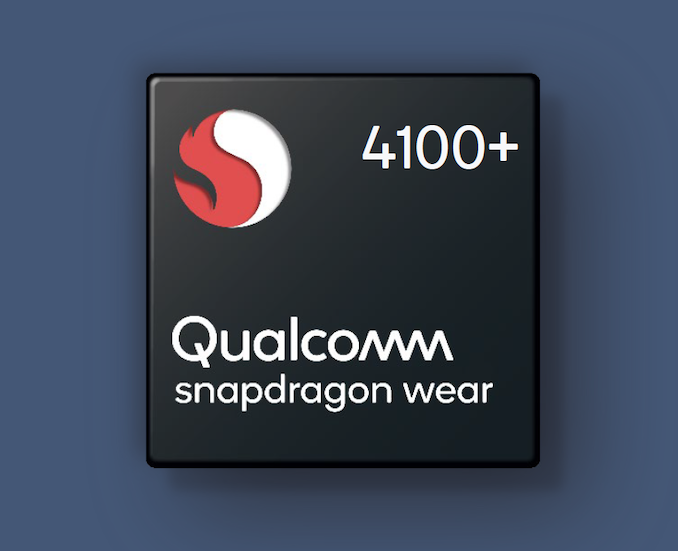
Today Qualcomm is making a big step forward in its smartwatch SoC offerings by introducing the brand-new Snapdragon Wear 4100 and Wear 4100+ platforms. The new chips succeed the aging two 2018 originating Wear 3100 platforms and significantly upgrading the hardware specifications, bringing to the table all new IPs for CPU, GPU and DSPs, all manufactured on a newer lower power process node.
Smartwatch products over the last few years had always one big criticism to them, and that was the fact that the SoCs powering them were always seemingly underpowered compared to what we’re seeing from the like of vertically integrated vendors such as Apple and their own smartwatch SoCs. Qualcomm’s new Wear 4100 SoC now finally abandons the Cortex-A7 cores and 28nm process in favour of Cortex-A53 cores and a 12nm process – whilst certainly not bleeding edge, it’s a big jump in performance and power efficiency.
The new SoC is a complete overhaul in terms of design. As mentioned, instead of the quad-core A7 cores at 1.1GHz, the new chip now features quad A53 cores at up to 1.7GHz. The chip still relies on LPDDR3 as its memory technology but the clock rates have been upped from 400MHz to 750Mhz. The GPU has seen a giant leap in performance as it sees the jump of 2 architectural generations from an Adreno 304 to a new Adreno 504. The chipset also seen its DSP capabilities expanded as it now features a second dedicated audio DSP for actual application side processing (Alongside the modem DSP) that previously didn’t exist on the Wear 3100 chip.
An interesting addition to the SoC is a second ISP. The new chip is able to now handle dual 16MP cameras – some of Qualcomm’s customers have ideas for smartwatch products which would deploy two cameras.
The main SoC is now manufactured on a newer 12nm process node at TSMC – it’s certainly not the newest node given a new platform like this, but Qualcomm probably made their cost-performance calculations when choosing this design aspect.
It's to be noted that it looks like Qualcomm did recycle the design from the Snapdragon 429 - although it's possible the Wear variant here might be specifically binned for low power usage.
Connectivity wise, the chip still employs a LTE category 4 modem with up to 150Mbps down and 50Mbps up speeds, but the new RF system includes optimisations for power usage, such as the new addition of eDRX (Extended discontinuous reception) for much better power efficiency. Bluetooth connectivity has been upgraded to the 5.0 standard.
Qualcomm continues to use a main SoC + co-processor architecture for its smartwatch platforms. The aforementioned Wear 4100 serves as the main processor chip during active and interactive usage of the device, whilst a secondary co-processor serves as the always-on silicon that is able to enable ambient non-interactive device use-cases (Essentially, powering on the screen with static / low-updating information).
The co-processor has a similar design to the QCC1110 that was bundled with the Wear 3100 platform, but has been enhanced in terms of some of its capabilities such as having richer colour depth rendering ability for up to 16 bit (64K colours).
The key aspect for using both a main SoC and a co-processor in the same device is the dual display architecture of the system, where the display is connected to both chip and can receive signals from both. The reason for Qualcomm to not have implemented a single monolithic chip is rationalised by design efforts and cost-opportunity; while they haven’t announced any products yet, they envision the possibility to use the QCC1110 as a standalone system in a device, and likewise, one can use the Wear 4100 without a co-processor.
The co-processor can serve as the sensor hub collecting data from your typical smartwatch sensors, all whilst the main SoC is powered off.
The overall improvements of the platforms bring a -20% decrease in power usage, all whilst increasing CPU performance by 85%, GPU performance by a massive factor of 2.5x. In terms of workload efficiency, you’ll be seeing significant increases – all needed in wearable devices as battery life is key.
The Snapdragon Wear 4100 platform represents the main SoC and surrounding essential components, whilst the Wear 4100+ platform also includes the co-processor for augmented always-on operation. The new platforms are available and shipping to vendors now.
Related Reading:
- Qualcomm Launches Snapdragon Wear 3100 Platform for Smartwatches
- Qualcomm Announces Snapdragon Wear 2100 IoT SoC
- Qualcomm Announces Snapdragon Wear 1200 SoC: LTE Categories M1 & NB1 for Wearables & Smart Trackers
- Qualcomm Announces Snapdragon Wear 1100 SoC For Wearables
- Apple Announces The Apple Watch 4: Fully Custom SiP


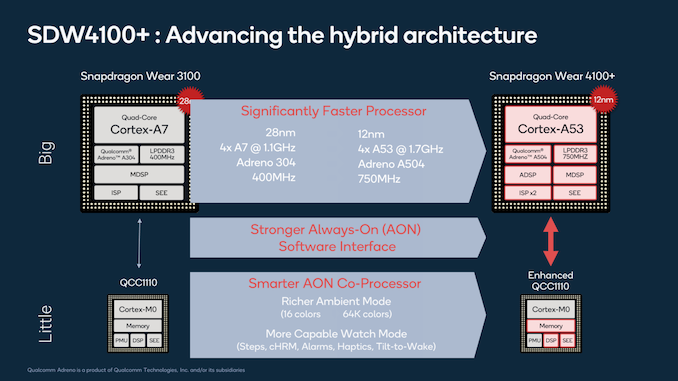
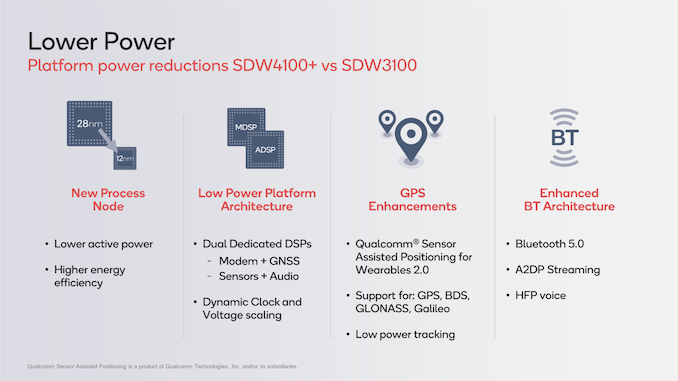
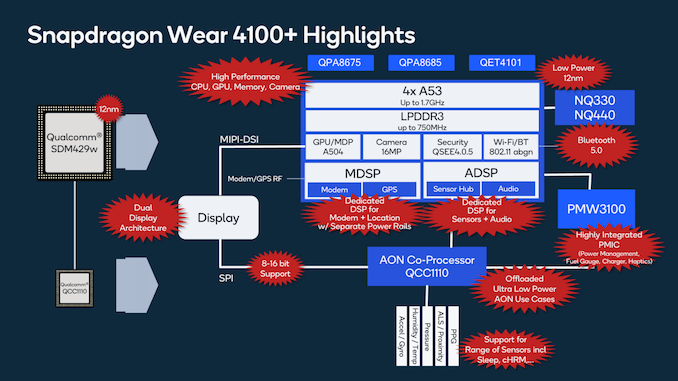
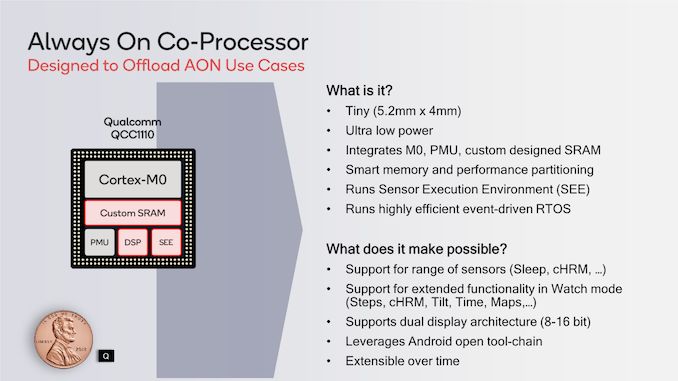
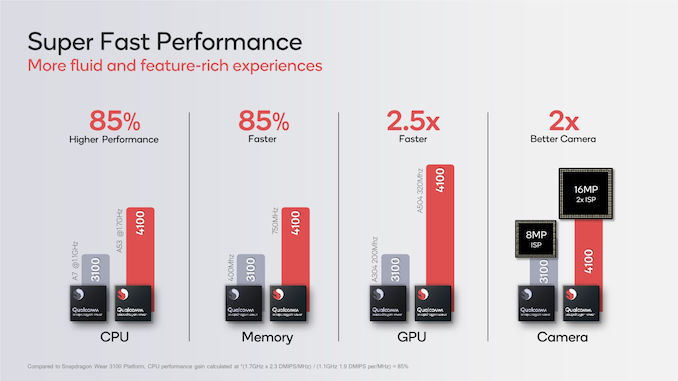








33 Comments
View All Comments
dotjaz - Friday, July 10, 2020 - link
Nobody in the wearable space would go below 10nm. It's just not worth it.ZoZo - Tuesday, June 30, 2020 - link
ARM Cortex-A55 was launched in 2017. According to Wikipedia: "The Cortex-A55 serves as the successor of the ARM Cortex-A53, designed to improve performance and energy efficiency over the A53"Why on Earth would they not use that design?
And just as confounding, smartwatches are starving for efficiency more than smartphones let alone desktop processors, all of which have been benefiting from 7nm for at least a year, so why won't those smartwatch processors be manufactured using at least 7nm?
ZoZo - Tuesday, June 30, 2020 - link
The Apple Watch can sleep soundly for another while.Is there any competition on the horizon?
Quantumz0d - Tuesday, June 30, 2020 - link
Qualcomm probably sees Android Wear platform as very small marketshare, Apple conquered the wearable by more than 50% I think. 7nm is definitely not making to the Wear, they want a lot of margin, 7nm would be detrimental to that idea plus wear devices I don't know how long they last, phones are 2years tops.deil - Wednesday, July 1, 2020 - link
android wear stuff was haing horrible battery life (like 4h) so it was dead on arrival.now that there will be a chance for full day usage, it accually can make sense.
but in here smart bands that expand phone cappabilites + andorid is the majority, not the standalone androwear stuff.
melgross - Thursday, July 2, 2020 - link
The problem that Android users won’t face is the cost. When the average Android phone costs less than $240 around the world, it’s hard to expect people to buy a full featured smartwatch that costs the same, or even more for better models. That’s a major reason it failed.When the Motorola 360 first came out, posters on Arstechnica raved about it. Even though it looked terrible, and really cheap, with the stamped case, and cut off screen, they were saying how it was the most beautiful watch they’d ever seen. But I’m willing to bet that almost none of them bought one, or any later models from anyone. It was over $300.
It seems too little, too late. This chip still can’t compete with the latest Samsung chips for their own watches, much less Apple’s chips for theirs. I’d be willing to bet that if Apple were able to have their watch be completely independent of the iPhone, and they’ve been working towards that goal over the years, it would still outsell AndroidWear with Android buyers, since the least expensive Watch is $179, and lower on some sales. No full featured AndroidWear watch could match that.
dotjaz - Friday, July 10, 2020 - link
You'd be so naive thinking 7nm is power efficient at all performance nodes. 7nm is only more power efficient at higher frequencies. At lower performance, LEAKAGE becomes dominant. 7nm would suck running at low frequencies.In case you hadn't notice the very first Apple S1 launched in 2015 was using 2013's 28HKMG because 28nm was optimised for low leakage by then. Intel did something similar with 22FFL which is a relaxed, ultra low leakage version of their 14nm.
RSAUser - Saturday, July 11, 2020 - link
Erm, no, because you'd be able to hit a higher frequency you only need to turbo for shorter, so the watch will feel more responsive while going into idle sooner, it will result in a net saving.Most of the leakage problems at 7nm are not that bad, assuming you were looking at 2016/2017 papers to base your opinion off of?
Eliadbu - Sunday, July 12, 2020 - link
wrong assumption about frequencies. while higher frequencies is nice most of the time and for most uses the watch does not need to have higher frequencies. the aim with a wearable is to have the lowest power consumption ALL the time so it can have battery life for days if not weeks. an ultra low power optimized process node is designed for such uses. currently there are no such process for 7nm transistors and no planes. while it might be possible to create such process, current leakage is a known issue with smaller transistors features.dotjaz - Monday, July 13, 2020 - link
I'm based off the fact that NO FOUNDRY has yet announced any plan to go below 10nm with their ULP/ULL processes. That means you won't see any in the next 3 years.The problem IS idle, leakage makes it ridiculously not worth it.
If you are so well-informed, why don't you go and help TSMC design N7ULL/ULP? Their current best offering is N28ULP/ULL, and N22(ULP) is probably in risk production stage.